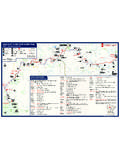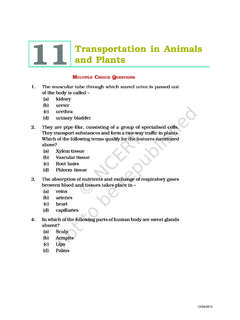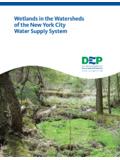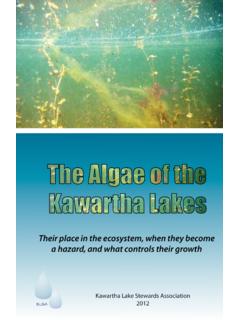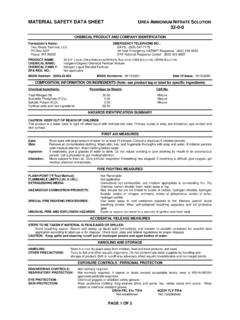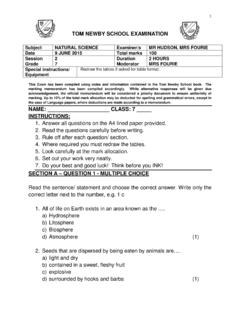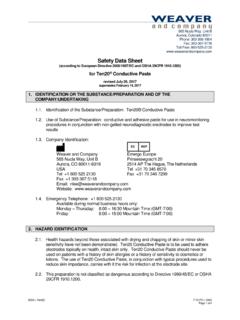Transcription of 1.6 WESTON® TNPP - lpi-intl.com
1 SAFETY DATA SHEET Version: Date of Issue: weston tnpp Date printed: (M)SDS# 000000021515 Page: 1 of 8 Chemtura Corporation urges the recipient of this Safety Data Sheet to study it carefully to become aware of hazards, if any, of the product involved. In the interest of safety you should (1) notify your employees, agents and contractors of the information on this sheet,(2) furnish a copy to each of your customers for the product, and (3) request your customers to inform their employees and customers as well. 1. IDENTIFICATION OF THE SUBSTANCE / PREPARATION AND OF THE COMPANY / UNDERTAKING Identification of the substance or preparation: weston tnpp Chemical name: Tri(nonylphenyl)phosphite Synonyms: FDA Liquid Phosphite Use of substance/preparation: Polymer stabilizer Company identification: Galata Chemicals GmbH Chemiestra e 22 Lampertheim 68623 Germany Manufacturer: Galata Chemicals GmbH Chemiestra e 22 Lampertheim 68623 Germany Emergency telephone number: NA: +1-760-476-3962 Access Code: 333257 EU: +1-760-476-3961 Access Code: 333257 AP: +1-760-476-3960 Access Code.
2 333257 +1-760-476-3971 Access Code: 333256 Environmental, Health and Safety Department: Tel.: +49-6206-95-70 Prepared by Product Safety Department Date of Issue: (US) +985-783-6201 (EU) +49-6206-95-70 2. HAZARDS IDENTIFICATION Main hazards and effects: Irritating to skin. May cause sensitization by skin contact. Very toxic to aquatic organisms, may cause long-term adverse effects in the aquatic environment. 3. COMPOSITION / INFORMATION ON INGREDIENTS INGREDIENT % BY WEIGHT HAZARD DANGER SYMBOL(S) Phenol, nonyl-, phosphite (3:1) CAS# 26523-78-4 > 95 R38 R43 Xi N SAFETY DATA SHEET Version: Date of Issue: weston tnpp Date printed: (M)SDS# 000000021515 Page: 2 of 8 EINECS/ELINCS# 247-759-6 R50/53 Nonylphenol CAS# 84852-15-3 EINECS/ELINCS# 284-325-5 < 5 R22 R34 R50/53 R62 R63 C N 4.
3 FIRST AID MEASURES Swallowing Obtain medical attention immediately. Inhalation Remove to fresh air. Obtain medical attention immediately. Skin contact Immediately wash with soap and water for at least 15 minutes. Immediately remove contaminated clothing and shoes. If redness or irritation occurs, seek medical attention. Eye contact Remove contact lenses, if worn. Immediately flush with large quantities of water on site for 20 to 30 minutes. The eyelids should be held open and away from the eyeball to ensure that all surfaces are flushed thoroughly. Call a physcian. Continue water flush up to one hour during transport to a medical facility. Obtain medical attention if irritation persists.
4 5. FIRE-FIGHTING MEASURES Flash point: 207 C Hazardous combustion products Carbon dioxide. Carbon monoxide. Oxides of phosphorous. Phosphine. Special fire fighting procedures Water spray may be used to cool containers and adjacent surfaces. Run-off water may be highly acidic and should be collected and neutralized if possible. Special protective equipment for firefighters Firefighters must be equipped to prevent breathing of vapors or products of combustion. Wear an approved self-contained breathing apparatus and protective clothing. Full protective clothing Extinguishing media Suitable: - CO2 - dry chemical - foam Unusual fire and explosion hazards Hazardous combustion products may include intense heat, dense black smoke, carbon monoxide, carbon dioxide, hydrocarbon fragments, phosphine, fragments of phosphite/phosphate esters and oxides of phosphorus.
5 6. ACCIDENTAL RELEASE MEASURES Personal precautions Wear protective clothing when taking up spill., Avoid contact with eyes and skin. SAFETY DATA SHEET Version: Date of Issue: weston tnpp Date printed: (M)SDS# 000000021515 Page: 3 of 8 Environmental precautions Avoid drainage to sewers or natural waters., Since phosphites can hydrolyze, notification of governing agencies may be appropriate due to the possible release of phenolic materials. Methods for cleaning up Avoid contact with liquid and vapors. Dike area of spill to prevent spreading and pump liquid to salvage tank. Absorb residue with inert absorbent, and transfer to proper containers.
6 Remaining material may be emulsified with soap and water and absorbed on additional sorbent. Do not flush to sewer. Since phosphites can hydrolyze, notification of RCRA may be appropriate due to the possible release of phenolic materials. Do not flush this product to sewers or waterways. 7. HANDLING AND STORAGE HANDLING Handling precautions Avoid contact with skin and clothing., Avoid prolonged or repeated contact with skin., Wash thoroughly with soap and water after handling., Do not eat, drink or smoke when handling., Keep containers tightly closed to prevent contamination., Electrically bond and ground all containers and equipment before transfer or use of material.
7 , Normal precautions common to good safety practice should be followed in handling. Other precautions Caution - If water contamination has occurred, or if you have any reason to suspect water contamination, do not heat containers of product. Do not heat opened containers with steam in a manner which will allow steam to condense into the container. STORAGE Storage requirements Keep away from heat, sparks and flame., Store in a dry place away from excessive heat., Keep container tightly closed., Exposure to moisture or high humidity can cause hydrolysis producing phosphorus acid and nonylphenol., Normal precautions common to safe manufacturing practice should be followed in handling and storage.
8 8. EXPOSURE CONTROLS / PERSONAL PROTECTION EXPOSURE LIMIT VALUES PERSONAL PROTECTION Respiratory protection None required in normal use., NIOSH approved full face organic respiratory protection required in the absence of proper environmental control. For emergencies, a self-contained breathing apparatus and full chemical resistant suit. Hand protection / protective gloves Chemical resistant protective gloves Eye protection Safety glasses with side shields., Safety goggles. Skin protection Wear protective clothing. Industrial hygiene measures Do not eat or drink at work., Remove contaminated clothing and clean it. ENGINEERING CONTROLS Ventilation Use local ventilation or engineering controls as needed to maintain personnel exposure below the exposure limits.
9 Further information Provide for sufficient ventilation and/or exhaust. SAFETY DATA SHEET Version: Date of Issue: weston tnpp Date printed: (M)SDS# 000000021515 Page: 4 of 8 9. PHYSICAL AND CHEMICAL PROPERTIES APPEARANCE Physical state Liquid Color Colorless to light yellow Odor Slight phenolic Odor threshold No data available. OTHER PROPERTIES Boiling point Not available Melting point Not available Solidification Not available pH Not available Specific gravity (H2O=1) Not available Density 0,98 g/cm3 at 25 C Solubility in water Insoluble, Hydrolyzes slowly Solubility in organic solvents No data available.
10 Partitioning coefficient No data available. Flash point 207 C Method: Pensky Martens closed cup Autoignition temperature 439 C Upper explosion limits Not available Lower explosion limits Not available Percent volatiles Not available 10. STABILITY AND REACTIVITY Stability: Stable. Stability - Conditions to avoid: Moisture. Water. Incompatible materials: Water. Hazardous reactions: Will react in the presence of water. Reaction rate will increase with increasing temperatures and pressures. Hydrolyzed by moisture to phosphorus acid and nonylphenol. Hazardous combustion products: Carbon dioxide. Carbon monoxide.


